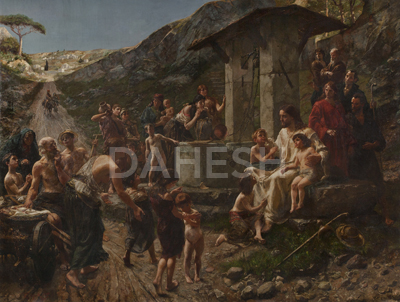Franck Kirchbach (German, 1859–1912)
Christ and the Children, 1894
Oil on canvas, 114 1/2 x 151 1/4 in.
Signed and dated lower left: F. Kirchbach 1894
1995.3

Christ and the Children, which was exhibited in the Paris Salon of 1895, was an immensely popular painting across Europe and America for years after it was completed. Kirchbach represents the familiar story of Jesus blessing the children, recounted in the Gospel of Mark.
Seated next to a well, Jesus is identifiable by his humble yet gleaming white robe, but there is no halo or divine illumination to mark his presence. The work is heavily laden with symbolic elements and biblical allusions, and contemporary viewers would have delighted in decoding the various biblical references hidden throughout the painting. Of the five disciples placed behind Jesus, John stands out with his red robe, symbolizing love, while James’ blue robe represents unity. One twentieth-century source identified the well beside Jesus as Jacob’s Well, an ancient site associated with the biblical patriarch that has drawn pilgrims of various faiths for almost two millennia. According to John 4:5-6, Jacob’s Well was the site where Jesus conversed with the Samaritan woman. Viewers of the painting likely would have drawn connections between this and other biblical stories involving wells, most notable that of Rebecca.
The fisherman at the far left of the painting has momentarily forgotten about selling his catch and has turned his attention toward Jesus. The fish in the basket reminds the viewer of Jesus’ feeding of the multitudes with two fish and five loaves, which is the only miraculous event to appear in all four Gospels (Matthew 14:13-21, Mark 6:31-44, Luke 9:10-17, and John 6:5-15). In the distance, Kirchbach painted a bright landscape that was certainly informed by his travels in the Middle East. Personal references play a major role in the work as well: the figure of Jesus is a self-portrait, and his wife and children served as models for the woman dressed in blue with the baby in her arms and the child at Jesus’ feet.
After receiving an honorable mention at 1895 Paris Salon, the painting went on to be exhibited in Brussels, London, Vienna, Hamburg, Berlin, Amsterdam, Frankfurt, Munich, Milan, Dresden, Dusseldorf, and many other cities. In 1925, it was purchased by Laura Clubb, the American art collector in Kaw City, Oklahoma.


